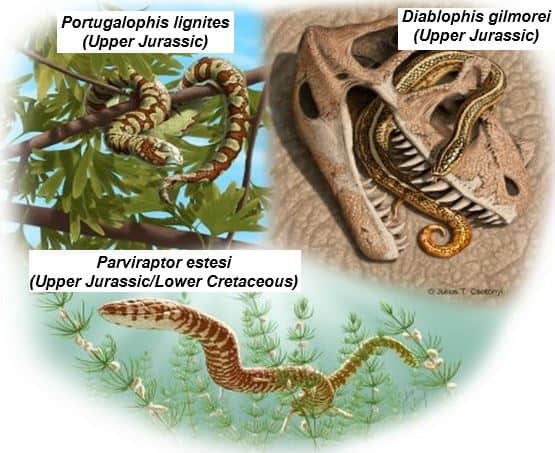The discovery by an international team of researchers of fossilized remains of four ancient snakes between 140 and 167 million years old will change how we think about their origin. They emerged much earlier than scientists had thought.
Snake evolution has now been rolled back by nearly 70 million years, says lead author Professor Michael Caldwell from the University of Alberta, Canada. The study has been published in this week’s issue of Nature Communications (citation below).
“The study explores the idea that evolution within the group called ‘snakes’ is much more complex than previously thought.”
“Importantly, there is now a significant knowledge gap to be bridged by future research, as no fossils snakes are known from between 140 to 100 million years ago.”

Artist’s conception of three of the four newly identified ancient snakes. (Credit: Julius Csotonyi. Image: University of Alberta)
The oldest known snake, Eophis underwoodi, came from Kirtlington, a village in Oxfordshire, England. However, not much is known about it from the very fragmentary remains of the small animal.
The largest snake, Portugalophis lignites, from coal deposits at Camadas de Guimarota, a disused coal mine near the city of Leiria in central Portugal, was a much bigger animal, about one meter long.
Many of these ancient snakes, such as Eophis, Portugalophis and Parviraptor, lived in swampy coastal areas on large island chains in western parts of prehistoric Europe.
Diablophis gilmorei, the North American species, was found inland in western Colorado in river deposits.
The authors explained:
“This new study makes it clear that the sudden appearance of snakes some 100 million years ago reflects a gap in the fossil record, not an explosive radiation of early snakes.”
“From 167 to 100 million years ago, snakes were radiating and evolving toward the elongated, limb-reduced body shape characterizing the now well known, ~100-90 million year old, marine snakes from the West Bank, Lebanon and Argentina, that still possess small but well-developed rear limbs.”
Our understanding of snake evolution has now changed
Prof. Caldwell points out that the identification of definitive snake-skull features shows that the fossils – which had previously been labeled as non-snake lizard remains – come from a much earlier time frame than when we thought snakes first appeared.
Prof. Caldwell explained:
“Based on the new evidence and through comparison to living legless lizards that are not snakes, the paper explores the novel idea that the evolution of the characteristic snake skull and its parts appeared long before snakes lost their legs.”
The researchers are certain that there are even older snake fossils out there waiting to be found.
Citation: “The oldest known snakes from the Middle Jurassic-Lower Cretaceous provide insights on snake evolution,” Michael W. Caldwell, Randall L. Nydam, Alessandro Palci & Sebastián Apesteguía. Nature Communications. Article number: 5996. doi:10.1038/ncomms6996.
